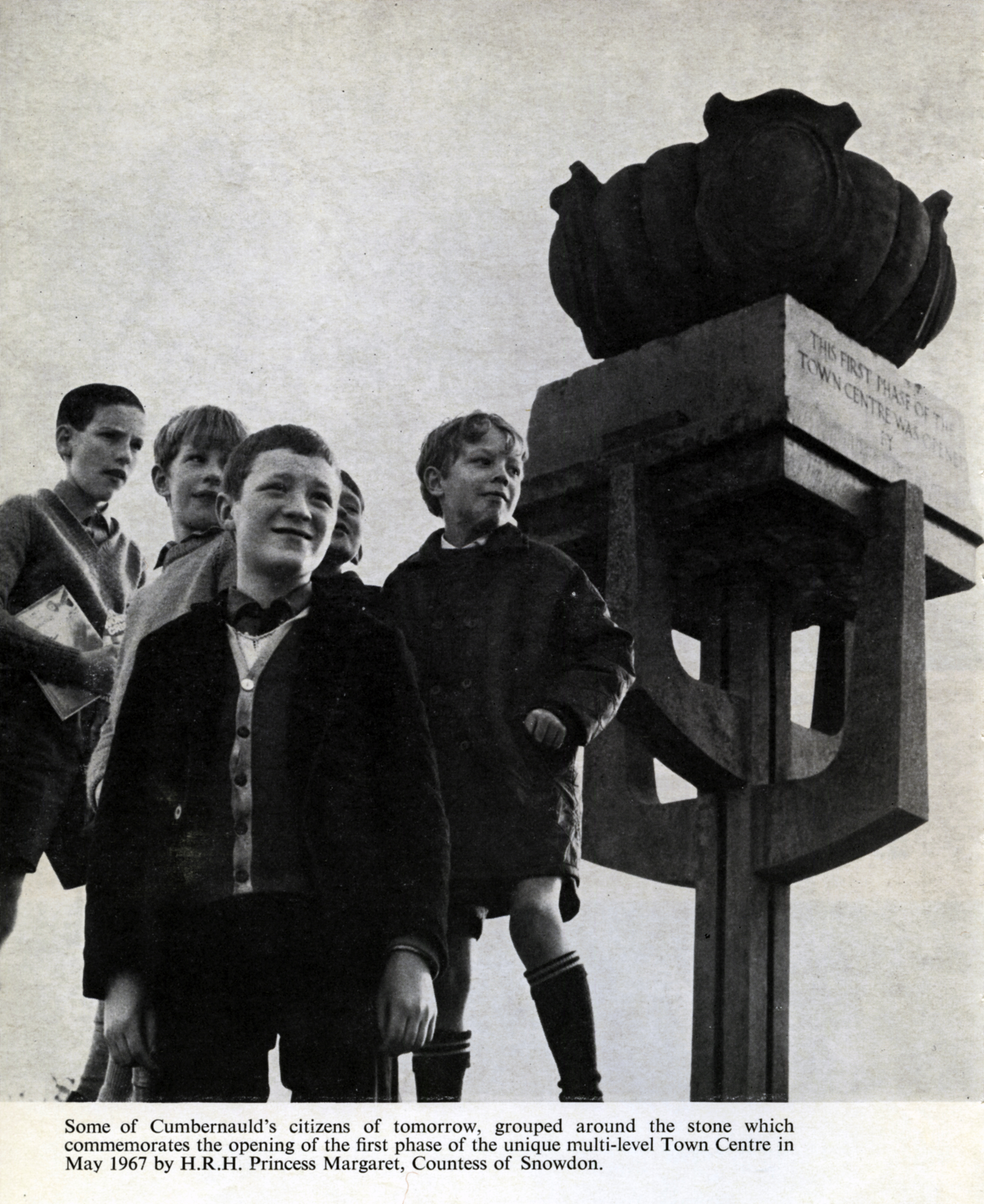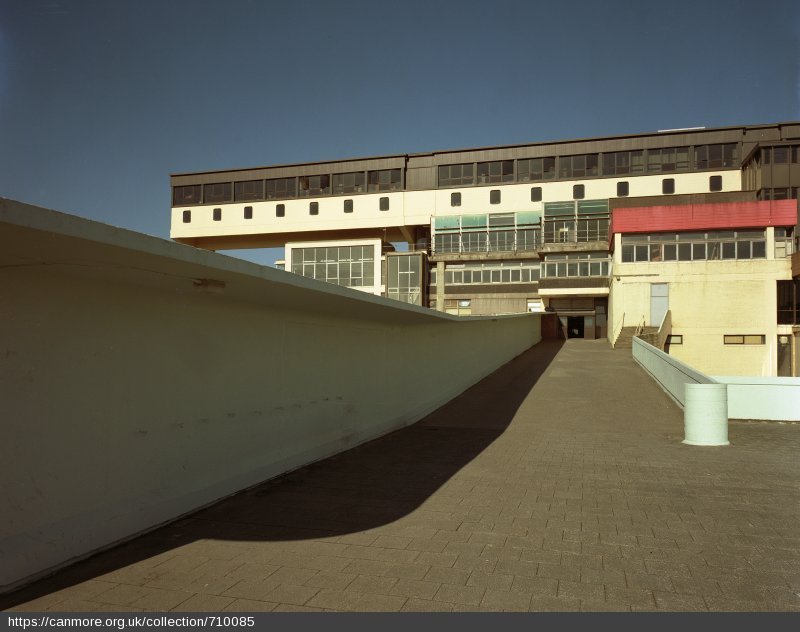Diane M Watters is an architectural historian. A specialist in nineteenth and twentieth century architecture and conservation in Scotland, she has recently authored St Peter’s Seminary, Cardross: Birth Death and Renewal (HES, 2016), and co-authored a guide to Cumbernauld (with Miles Glendinning) as part of Buildings of Scotland architectural guidebook series to Lanarkshire and Renfrewshire (Yale University Press, 2016). She teaches at the University of Edinburgh.

In its sixty-odd year history Cumbernauld has been celebrated, neglected, and reviled – in that order. Despite being an ambitious multi-award winning 1960s setpiece of post-war architecture and planning, by the early 1990s Cumbernauld had acquired a notorious reputation as one of Scotland’s most reviled products of that era. The town’s fabric suffered with the winding up of the governing Cumbernauld Development Corporation in 1996, and renewed academic and heritage interest in the 90s did not stop the phased demolition of the infamous Town Centre in 1999. The new millennium brought more derision: media-generated anti-awards, such as the UK’s second-most ‘Crap Town’ in 2003, and the notorious ‘carbuncle’ Plook on a Plinth award of 2001, which compared Cumbernauld to Kabul. More recently the ongoing programme of tower block removal began.
As someone who grew up in Cumbernauld and has researched the history of the town, I don’t recognise these so-called ‘popular’ condemnations. Why not? On a factual level, the real story of Cumbernauld is much more complex than the ‘failed Utopia’ narrative pedalled by much of the media and ‘experts’. And secondly, on a personal level, my childhood recollection is not one of deprivation induced by living in a soulless unworkable ‘concrete jungle’. Instead, Cumbernauld has both shaped my views of society, and had a profound effect on my work.
A Reputation Lost?
From its inception in the mid 1950s, Cumbernauld was a place of international architectural standing. It was one of the world’s first large-scale realisations of a new generation of intensely planned urban settlements. In design terms it reacted against the spaced-out ‘neighbourhood unit’ layouts of earlier New Towns like East Kilbride whose housing, industry and other functions all divided into separate zones. In Cumbernauld, the most important functions would instead be clustered together: the Town Centre would become a single, multi-level, multi-purpose ‘megastructure’ on the crown of the hill. The housing would be set within a restricted oval belt around the Centre, and the traffic network completely segregated vehicles and pedestrians. All this was to be knitted together by hard and soft landscaping.
In 1967 (incidentally, the year I was born) the town won the prestigious American Institute of Architects R S Reynolds Award for Community Architecture. In a single typical week in 1968, it was visited by 18 French architect-planners, 13 Danish engineers, 23 Dutch members of the International Society of City and Regional Planners, the city architect and deputy city engineer of Auckland, New Zealand, and three delegations of US architects and estate consultants. Cumbernauld was designed and built in a period of unprecedented innovation in architecture and planning, but it was that same architectural world, with its ever-shifting opinions and fashions, which also reacted against it. The failure of the original Town Centre concept was increasingly lumped in with the more modest housing and public buildings which surrounded it. Amidst a general anti-Modern Movement architectural climate in the 80s, it was an easy ride downhill for Cumbernauld. It was almost as if its international architectural reputation had been forgotten.
A Democratic Town?
My experiences contrast strongly with these ‘elite’ interpretations of Cumbernauld, and instead align with the broadly positive 60s and 70s accounts by the mainstream media (including the good old Cumbernauld News) and the townsfolk themselves. One said ‘the children I saw (they went about in shoals) were having a whale of a time with never a car to bother them’, and concluded the town had ‘the neighbourliness of Glasgow without its grubby streets, and the privacy and freshness of the countryside without its loneliness’. My own family had moved from Govanhill, Glasgow to our new three-bedroom Cumbernauld terrace house in early 1964, after an inspection of their tenement flat to establish ‘levels of cleanliness’ – which according to Watters family folklore involved checking under the beds. Kildrum was the first housing area to be built in the town, and by 1964 my family had a variety of amenities provided for them: a temporary village centre in Muirhead, Seafar (the main Town Centre was still under construction); new churches, new schools, and the all-important Cottage Theatre. So, amongst young families the future was bright, and optimism high – as typified in the fantastic 1970 promotional film Cumbernauld: Town for Tomorrow.
Personally looking back, two overriding memories dominate: the overall feel of the townscape pattern, and a shared sense of community optimism. Aged five, I toddled-off to Kildrum Primary School (demolished 2004), through a network of landscaped pathways. Everything modestly had a place within the broader plan, and no one building shouted out at you (apart from the Town Centre of course). I felt very strongly that I was living, walking, and playing in a carefully constructed (and safe) environment.
The socially ‘democratic’ ethos of Cumbernauld is more difficult to pinpoint, but from a child’s perspective, my happy ‘mixed’ community typified the town. My next door neighbours were a Catholic family from Glasgow, and despite being at different denominational schools the children from both families were virtually brought (some might say dragged) up together. From the outset it was estimated that Cumbernauld would have a Catholic population of 12-13,000, and larger houses were designed: integration was seen as essential for this new west of Scotland community. All children attended the local schools, with the sons and daughters of medics, architects, planners and managers mixing happily with blue and white collar workers. Cumbernauld fostered, for me at least, a spirit of mobility.
The New Town ethos of aspirational mobility, however, gradually began to work against Cumbernauld’s social cohesion, with many moving elsewhere or to private housing developments built in the town’s northern extensions. I too left my hometown in the late 80s to go to University and develop a career researching and writing about Scotland’s Modern architecture – including my beloved Cumbernauld.
—
Diane co-leads a walking tour of her home town during ReimagiNation: Cumbernauld; you can book tickets now here.
She also discusses her book on the restoration of St Peter’s Seminary, a ruined Modernist church in Cardross, on Saturday 20 May too. Learn more and book here.

Share this Post


